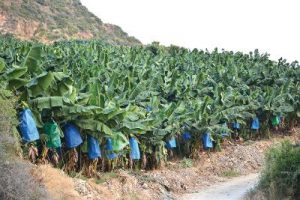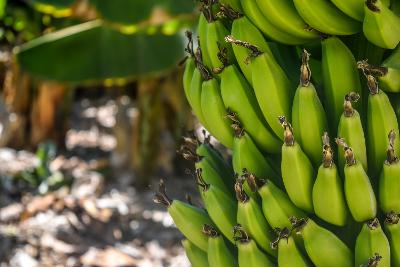In highly developed countries, bananas are prized as a food of convenience – it’s cheap, portable, and reasonably healthy. Among the variety of fruits that land on our tables, the banana is just one of the many to choose from.
However, unbeknownst to most, banana plays a critical role in the global food supply chain. According to the UN, countries such as Uganda, Gabon, Ghana and Rwanda – all least developed, low-income and food-deficit nations – rely heavily on bananas and plantains to meet the minimum requirement of 300 calories per person, per day, to live. The simple banana, cheap, portable and convenient as it is for its more affluent customers, has a much bigger role to play not only as a commodity for trade, but as a means to survive for the least of its consumers.
The term food security gets thrown around a lot, and for the most part, we are unable to see the far-reaching consequences once a particular crop becomes extinct. History bears witness to cases such as the Great Famine of Ireland, where the humble ‘Lumper’ potato and its scarcity led to the country’s devastating famine from 1845–1849. Then, there is the banana industry’s Gros Michel (aka Big Mike). Once the dominant export banana to Europe and North America until the 1950s, Panama disease wiped out vast tracts of Gros Michel plantations in Central America.
Aside from skyrocketing fuel prices, operational costs, and labor challenges, the industry must also weigh in the repercussions of monoculture with disease and pestilence, close at its tail. If left unaddressed, the result would be debilitating famine.
 WHERE ARE WE NOW
WHERE ARE WE NOW
Bananas are among the most produced, traded, and consumed fruits globally. There exist more than 1,000 varieties of bananas in the world, and the most traded variety is the Cavendish banana. This variety is the most commercialized type, proving to be better suited to international trade than other varieties since it is more resistant to physical shocks during transport.
World banana trade has expanded to unprecedented heights in recent years, with an estimated export volume of 21 million tonnes in 2019. Key drivers of trade include abundant supply growth in the leading export countries of Ecuador and the Philippines, and a significant increase in import demand, particularly by China and the European Union (EU). Refer to table 1 below.
Table 1 : Philippine Banana Exports to Destination Countries (Year 2019 to 2020)
in thousand tonnes:
|
Country |
2019 |
2020 |
|
Japan |
1403.9 |
1414.7 |
|
Iran |
189.5 |
214.8 |
|
Saudi Arabia |
191.8 |
154.4 |
|
China |
1603.2 |
1210.1 |
|
China, Hong Kong SAR |
78.6 |
65.1 |
|
Singapore |
45.3 |
37.1 |
|
Korea, Rep of |
547.9 |
435.8 |
|
United Arab Emirates |
149.8 |
61.7 |
|
Others |
192.7 |
214.0 |
However, despite the demand, the banana industry continues to face threats not only on a domestic scale but also on the global stage.
KEY ISSUES & CONCERNS IN THE BANANA INDUSTRY
In consultation with industry stakeholders and studies, there surfaced common existing and emerging issues and concerns. These issues are interlinked with the various aspects of the industry and are usually not isolated incidents specific to certain areas or sectors. Many of the issues adversely affect the production and value chains of the different varieties of banana.

1. STIFF COMPETITION GROWS
On a country level, the largest producing and exporting countries in 2017 were spread out across geographic regions, with Ecuador at USD 3 billion, Costa Rica at USD 1.1 billion, and the Philippines at USD 1 billion. The largest importing countries that year were the United States (USD 2.5 billion),
Belgium (USD 1.4 billion), and Russia (USD 1.1 billion). While Asia is the largest banana-producing region, Latin America and the Caribbean is the largest exporting region, responsible for approximately 80% of global exports.
Despite these figures, the banana trade balance (export–import) has fluctuated significantly during the 2015–2018 period, registering oversupply in some years and shortages in others. This fluctuation is largely due to the seasonality in banana demand and climate related production challenges, such as severe floods, cooler temperatures, and mudslides.
In a span of 10 years, from 2010 to 2020, the Philippine Banana Industry continued to experience growing competition from Ecuador, China and Peru. Though the country has a strong market foothold on Japan and New Zealand, Banana Statistical Compendium 2020 indicates that the Philippines is dropping significantly behind.
Due to Typhoon Pablo, which damaged a large portion of the banana plantations in Mindanao, Philippine production dropped. While the Philippines was recovering, South American bananas were able to increase their market share in the Philippines’ traditional markets in Asia and the Middle East. The Philippines needs to a) recover these markets, and b) expand to new markets to regain its position in the world market, which has dropped from being number 2 to number 6 in a matter of years!
According to Philippines Banana Growers and Exporters Association (PBGEA) Executive Director Stephen Antig, China will be the next biggest export market due to its high population. Though there is a lot of competition mushrooming, Antig says “this is no longer a battle between companies, rather a competition between countries”. Examples can be found in the countries of Vietnam, Laos, and Cambodia with their low production costs. Also, all three are closer to the Philippines’ primary markets (Japan, and Korea), which makes transportation faster.
Antig adds that the Philippine banana industry is a sunshine industry and still the strongest one since we don’t depend on the government for assistance. “This industry is a huge taxpayer, with millions of dollars invested in CSR (Corporate Social Responsibility) alone. We are the second biggest exporter after coconut”. He also reiterates that there is a strong need to put up a research facility soon. “Thanks to our Filipino scientists and meticulous Bananeros, the edge we have as a banana producer lies in the quality of our products. However, sooner or later, unless we take care of our scientists and provide the infrastructure and facilities needed to make this happen, there may soon be a brain-drain in the country”.
2. DISEASE AND PESTILENCE THREATENS TO WIPE OUT AN INDUSTRY
Bananas have a claim to be the modern world’s first globalized product and still holds the record of being the most exported fruit on the planet. Yet the trade that began some 130 years ago must adapt to the fragility of globalization, which includes the threat of a pandemic, pestilence and disease.
Pests and diseases are a normal occurrence in any crop but more pronounced in a monocropping system where the spread and impact of the disease is faster. For bananas, Panama disease, Sigatoka and bunchy top are just some of the diseases that are hard to control and contain. Such pestilence causes lower production output with higher production costs since containing the infection requires stringent and costly sanitary and quarantine measures.
The banana sector is also facing a race against time, as Panama disease-resistant varieties such as the Cavendish are now being threatened by the new Tropical Race 4 (TR4) strain. Currently, farm workers are being issued protective clothing for themselves and disinfectant for their tools. The safety precautions are not only to guard against the coronavirus, but also to protect the valuable crop from TR4 which, similar to COVID-19, still has no cure, and poses an existential threat to a $25 billion industry.
3. OTHER CRITICAL THREATS TO THE INDUSTRY
CLIMATE CHANGE – Recent years have shown that extreme weather changes have led to widespread damage and has affected the productivity of the banana industry. Climate change is expected to lead to declining yields in the largest banana-producing countries, such as India, Brazil, Colombia, Costa Rica, Guatemala, Panama, and the Philippines, and consequently, a demand-supply imbalance in the years to come.
When Typhoon Pablo hit the Philippines, it affected about 25% of the commercial banana plantations which caused a downturn in production for the next two years, not including the periodic El Nino and La Nina occurrences, which significantly affected production, and eventually, the markets of bananas.
Sustainable production is also a challenge. The disproportionate use of pesticide has the potential of polluting freshwater sources if left unchecked. Being a major export product, transporting these perishable goods involve packing them in boxes, shipping in refrigerated containers, and artificially ripening with ethylene before they are sent to retailers and wholesalers. These steps, while important, contribute to greenhouse gas emissions.
PRODUCTION COSTS AND TRANSPORT – Spiraling production costs such as labor, freight, fertilizer, paper and board for boxes, and importantly, fuel, have gone from 50% to as high as 100%. Transport of the crop from farms to market is relatively expensive since most of the small farms are in hard-to-reach areas with inadequate road networks and transport facilities. A big percentage of the produce is transported by traders using small to medium sized vehicles that can enter the narrow roads, resulting in a high cost per volume transport cost.
And then there’s the INABILITY TO EXPAND PLANTATIONS due to civil/labor unrest, poor quality of soil, production costs of setting up farms, etc.
 WHAT 2022 HOLDS FOR THE INDUSTRY
WHAT 2022 HOLDS FOR THE INDUSTRY
Already on its last year, the Philippine Department of Agriculture’s Banana Industry Roadmap 2019 – 2022 priority projects include the (1) Organization of the Banana Industry Development Council, (2)
Establishment of the Banana Research Institute, (3) Conduct of the Banana Congress, (4)
Development of the Banana Database, (5) Acquisition of a Tissue Culture Laboratory or a Clonal Garden, (6) Acquisition of the Polycyclic Aromatic Hydrocarbon Laboratory Equipment and (7) best practices benchmarking for the industry.
However, for multinational companies such as Dole, it continues to educate itself on how to better address the issues of the business, the impact it has on the planet and its workforce. Though there is indeed a sensitivity when it comes to dealing with the pandemic, it was never business as usual for the organization. Re-aligning itself with its corporate values of taking people, planet and prosperity into account, Dole has measured deliverables with specific timelines called The Dole Promise to address these very urgent concerns in its own farms and plantations. The six pillars of the Promise are the following:
1. Dole promises to contribute to good and sustainable nutrition for 1 billion people by year 2025
2. Dole promises to work towards zero fruit loss from its farms to markets by year 2025
3. Dole promises to aim for zero fossil-based plastic packaging by year 2025
4. Dole promises to work towards net zero carbon in its operations by year 2030
5. Dole promises to work towards zero processed sugar and eliminating it in all our products by 2025
6. Dole is committed to be an equal opportunity employer that provides living wages and increased benefits for all stakeholders
Despite being a 170-year-old company, Dole together with its people, stakeholders and fellow industry players, will continue to shift and adjust to a radically changing market in a post-pandemic world.







